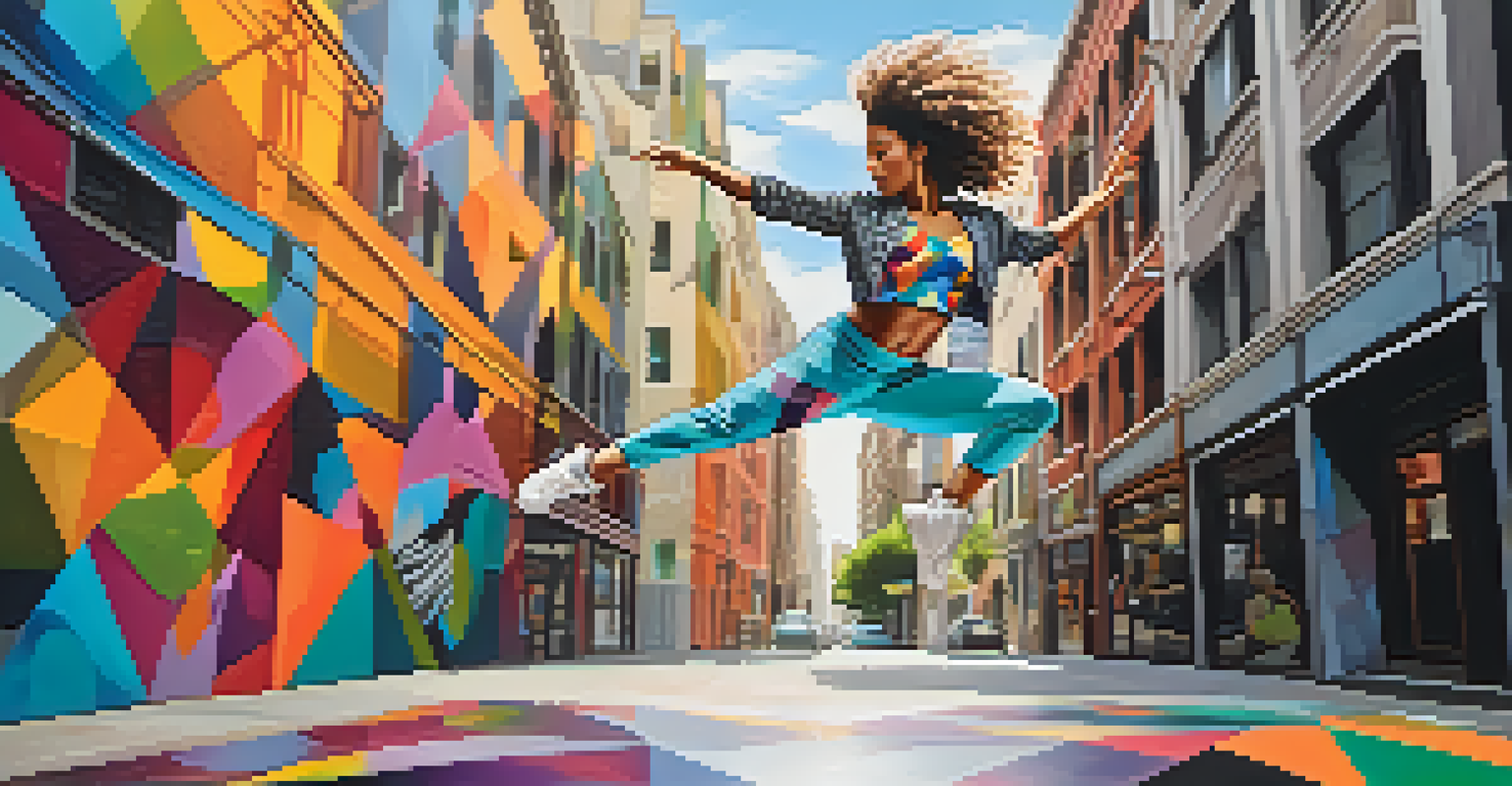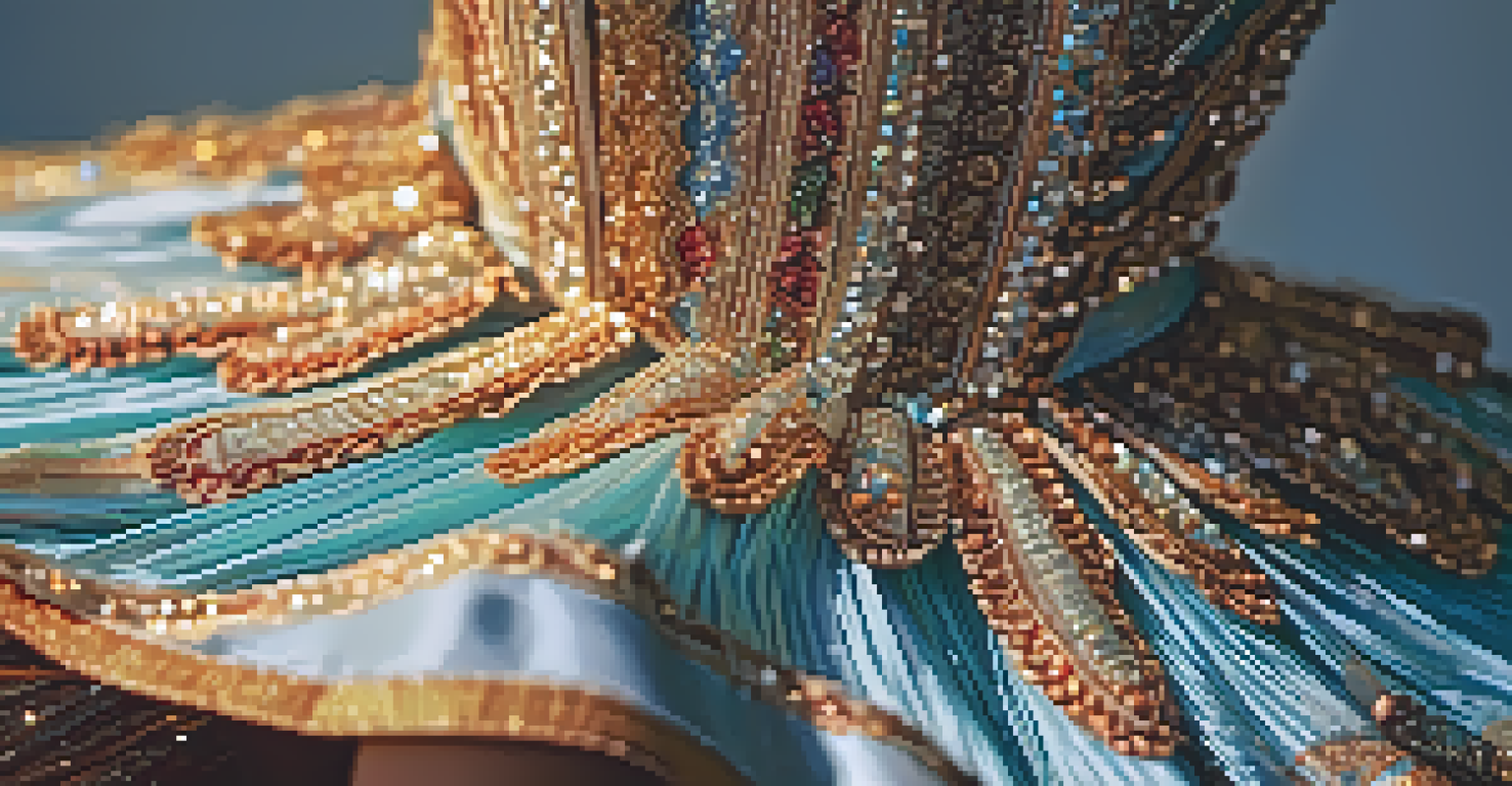Function vs. Aesthetics: Balancing Dance Costume Design

Understanding the Importance of Dance Costumes
Dance costumes are more than just clothing; they play a crucial role in storytelling during a performance. They help convey emotion and character while enhancing the visual experience for the audience. A well-designed costume can elevate a dance piece, making it memorable and impactful.
Dance is the hidden language of the soul.
However, the design of a dance costume must also take into account the physical demands of the performance. Dancers need costumes that allow them to move freely, without restrictions that could hinder their ability to execute complex choreography. This balance between aesthetics and functionality is essential for successful performance.
Ultimately, the right costume can amplify the narrative of a dance piece, making it a vital component of any performance. Designers must navigate the delicate interplay between visual appeal and practicality to create costumes that truly resonate with both dancers and audiences alike.
The Role of Functionality in Dance Costumes
Functionality in dance costumes refers to how well they support a dancer's movements and the type of dance being performed. For example, ballet costumes often feature fitted bodices and flowing skirts that complement the gracefulness of the dance. In contrast, street dance costumes may prioritize comfort and flexibility to allow for dynamic movements.

Materials are also key in ensuring functionality. Breathable fabrics can help regulate temperature during performances, while stretchy materials can accommodate a wide range of movements. Designers need to consider how each element contributes to the overall performance experience.
Dance Costumes Enhance Storytelling
Well-designed dance costumes convey emotion and character, elevating the overall performance experience.
Moreover, the practical aspects of a costume, such as how it is put on or taken off quickly, are essential for seamless transitions. This attention to functional details can make a significant difference in how a dancer feels and performs on stage.
The Aesthetic Appeal of Dance Costumes
Aesthetics in dance costumes involve the visual elements that capture the audience's attention and enhance the storytelling. Colors, patterns, and textures all play a role in how a costume is perceived, offering insight into the character or theme of a dance piece. For instance, vibrant colors might suggest energy and excitement, while muted tones could evoke a more somber mood.
Costume design is not just about making something beautiful; it's about enhancing the story and the movement.
Additionally, the design elements, such as embellishments or layering, can add depth to the visual experience. A costume that sparkles under stage lights can create a magical atmosphere, drawing viewers into the performance. However, designers must ensure that these aesthetic choices do not inhibit movement.
The balance between aesthetics and functionality is often a collaborative effort between choreographers and costume designers. Together, they can create costumes that not only look stunning but also support the artistic vision of the dance.
Finding Balance: Communication is Key
Effective communication between dancers, choreographers, and costume designers is vital to achieving a successful balance between function and aesthetics. Dancers can provide valuable insight into how a costume feels during movement, which can inform design choices. This open dialogue ensures that everyone involved understands the vision and practical needs.
Regular fittings and discussions can help identify any issues early in the design process. For instance, if a dancer feels restricted by a costume, adjustments can be made to enhance both comfort and visual appeal. This collaborative approach fosters a sense of teamwork and creativity.
Functionality is Essential for Movement
Costumes must allow dancers to move freely, balancing aesthetics with the practical demands of their dance style.
Ultimately, when all parties work together, the result is a cohesive artistic expression that resonates with audiences. This synergy leads to costumes that are not only beautiful but also functional, allowing dancers to shine on stage.
Costume Materials: The Backbone of Design
The choice of materials is a critical factor in balancing functionality and aesthetics in dance costumes. Fabrics must be selected not only for their visual appeal but also for their performance characteristics. For example, stretchy materials like spandex allow for freedom of movement, while glittery fabrics can add a dazzling effect without impeding performance.
Moreover, durability is essential. Dance costumes endure rigorous movements and must withstand wear and tear. Choosing high-quality materials can ensure that costumes maintain their beauty throughout multiple performances, making it a worthwhile investment.
Sustainable materials are also becoming increasingly popular in costume design, aligning with modern values of environmental consciousness. Designers can create stunning costumes that are both functional and eco-friendly, appealing to dancers who prioritize sustainability.
The Influence of Dance Style on Costume Design
Different dance styles have unique requirements and aesthetics that influence costume design. For instance, a ballroom dancer may need a flowing gown that accentuates their movements, while a contemporary dancer might opt for a form-fitting outfit that showcases their body line. Understanding these nuances is crucial for designers.
Cultural influences also play a significant role in the aesthetics of dance costumes. Traditional dance forms often feature specific colors, patterns, and styles that reflect their cultural heritage. Designers must respect and honor these traditions while incorporating contemporary elements.
Collaboration Drives Successful Design
Effective communication among dancers, choreographers, and costume designers is crucial for achieving a harmonious blend of function and beauty.
This understanding of dance styles helps designers create costumes that not only fit the performance but also resonate with the audience. When costumes align with the dance style, they elevate the overall experience, making each performance more impactful.
Conclusion: The Art of Costume Design
Balancing function and aesthetics in dance costume design is a true art form that requires careful consideration and collaboration. It's about creating pieces that not only look stunning but also allow dancers to perform to the best of their abilities. This blend of beauty and practicality is what makes a costume truly successful.
As dance continues to evolve, so too will the approaches to costume design. New materials, technologies, and design philosophies will emerge, offering exciting possibilities for future performances. Embracing these changes while maintaining the core principles of functionality and aesthetics is key.

In the end, the goal is to create costumes that enhance the performance, allowing dancers to express themselves fully. When this balance is achieved, the result is a captivating experience that leaves a lasting impression on audiences.